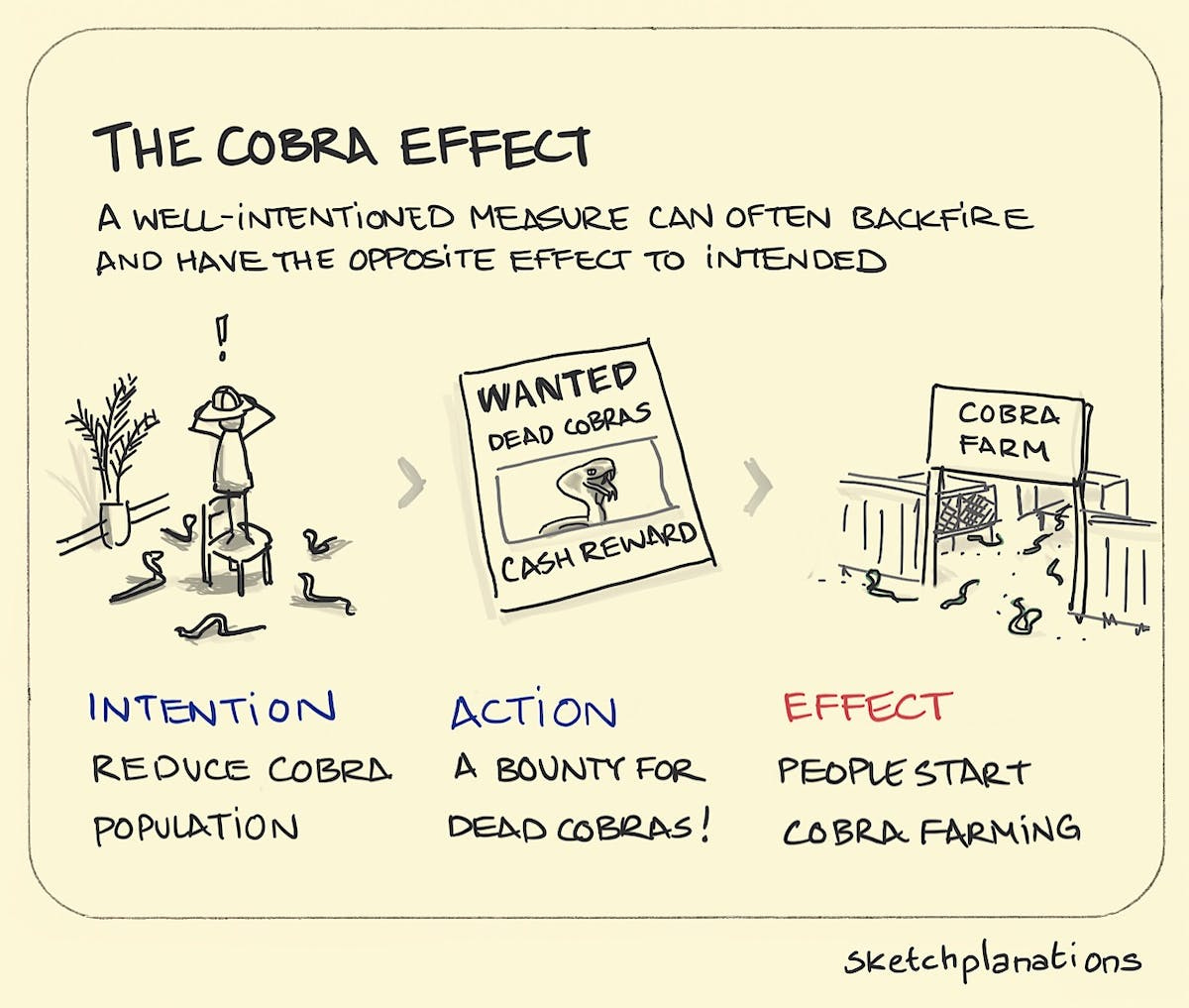"The road to hell is paved with good intentions."
Welcome to another edition of “Sebastian’s Leadership Reflections.” Today some thoughts around the idea of what’s called “The Cobra Effect,” or the unintended negative consequences of an incentive initially designed to improve society or individual well-being.
In colonial India during the British rule a curious phenomenon unfolded when the government was faced with the threat of venomous cobras and put in place a seemingly straightforward solution: offer a bounty for every dead cobra.
Initially, this strategy looked like a huge success, with a large number of hunted snakes. However things soon spiraled into a complex problem.
The cobra effect in motion
Individuals began breeding cobras to claim bounties, turning a well-intentioned incentive into a breeding program for these dangerous reptiles. When the government eventually learned about the situation and recognized the opposite effect that the reward program had and decided to eliminate it, the breeders released the now worthless snakes, exacerbating the initial problem.
This historical anecdote gave birth the concept of "The Cobra Effect," emblematic of well-intentioned strategies spiraling into unintended bad (or worse) outcomes.
During France’s colonial days in Vietnam, something similar to the problem in India occurred. Hanoi was overrun by rats so the authorities offered a reward for each rat’s tail found. As you can now imagine people started breeding rats solely for their tails, but millions of rats were released into the city when the offered reward vanished.
However, the Cobra Effect is not a relic of the past; it’s alive and well finding its way through the corridors of governments, corporations, even families. It manifests through any perverse incentive followed by bad unintended consequences.
For example, in 2016 we saw a paradigmatic case with Wells Fargo. Staff was under high pressure by the bank which had imposed unrealistic sales targets on them. Under the fear of losing their jobs, because failure to meet targets would have direct consequences, employees opened and created millions of unauthorized accounts to meet those aggressive sales targets. Employees were incentivized to open new accounts and as the sales target was so high, this led some to engage in fraud and unethical behavior.
Clearly, no perverse incentive should justify immoral or unethical behavior. It is always our choice to do what is right. We cannot blame third parties for the bad consequences caused by our own bad behaviors (to breed cobras and lie about having caught them in the wild, to open fraudulent accounts and lie about the origin non-existing new customers)… however the idea of paying attention to how wrong incentives can cause unintended harm and why they should be well thought before actions are put in place, is a very relevant one.
In the end, it goes back to the idea of ‘Second Order Thinking’, a concept I already discussed in the newsletter titled “Chesterton’s Fence” (the link below).
Botton line: You should not launch a program without at least attempting to answer the following question: “and then what?”
It’s easy to anticipate the immediate results of our actions, this is what’s called “first order thinking”. However “second order thinking” requires to think ahead and in a more comprehensive way. You need to think not just the consequences of the immediate actions, but he consequences of those consequences… The release of the extra populations of cobras by the people that now had no incentive to keep them because when the government realized of the scam decided to stop the reward program, led to a consequences far worse than the initial problem. The overall population of cobras had increased dramatically due to the artificial breeding, becoming now an even bigger threat to the general population.
So, not only was not the right incentive to pay for every dead cobra (because it triggered the greed of breeding them for money), but it was even a worse decision to stop the reward program right away without thinking that millions of cobras would be released to the wild after.
The term “Cobra Effect” was coined by Horst Siebert, a German economist at the University of Bonn to explain the effect that takes place when a well-intended plan leads to unintended consequences, making the problem actually worse instead of solving it. When businesses or governments offer incentives to encourage people to conduct a specific, pro-social activity, the Cobra Effect highlights the unforeseen repercussions and perverse outcomes that might follow.
“In business, we see the concept of the “cobra effect” all the time. Business leaders make well-intended decisions to fix a problem or drive a result. However, if it is not well thought out, it can actually make a situation worse. I have witnessed companies over-incentivizing sales reps for selling products or services that do not benefit their clients or even their own business. Sales reps, in turn, often shift their focus to selling the misaligned solutions. This creates a negative experience for the customer and can be detrimental for the business. If everyone is focused on short-term gain, they only create a larger problem.” Forbes magazine, 2020
The Essence of Perverse Incentives
Perverse incentives, despite being crafted with benevolent intentions, inadvertently foster undesirable behaviors. The misalignment between intended outcomes and incentivized actions creates a chasm, wherein unethical practices and unintended consequences proliferate. In the corporate realm, this often manifests through strategies that, while aimed at boosting performance, inadvertently incentivize counterproductive or unethical behaviors.
The Cobra Effect serves as a serious reminder of the intricate interplay between intentions, incentives, and outcomes. Leaders, in their pursuit of excellence, must meticulously design incentives that not only drive performance but also uphold ethical imperatives, cultural values, and strategic imperatives.
This is why incentives should not merely be a carrot dangled to elicit behaviors, but must be intricately woven into the ethical and strategic fabric of the organization. An example of this is how proper performance evaluation is done in organizations, not only considering WHAT was done but HOW it was achieved with respect to expected values and behaviors.
How to prevent this to happen
When planning a solution to a problem or an incentive program, it is very important to ensure the following steps in order to minimize the risk of the cobra effect:
Feedback - How will you correct errors in the design? Ask as many internal and external stakeholders as possible to pressure test what you are doing
Test and Evaluate - Before going all in do pilots to calibrate expectations and learn as much as you can as early as you can
Feedforward - How will you prevent errors in implementation? Ask questions that will help you include recommendations and encouragement on how to handle stakeholders complaints as they happen, in real time.
As previously stated, I cannot walk away from my unwavering belief in personal responsibility, so it is important to also demand it from our teams to avoid excuses. We bear the ultimate responsibility for our choices. However, we also have the responsibility to design an incentive system that is strategic in addressing specific issues, that is fair and is effective, that has control systems embedded to learn early of failures and adapt and that never deviates from the initial intended problem
This is the crux of the matter. There are instances where the incentive itself may not inherently lead to unethical conduct or fraudulent activities. However, it's equally crucial to scrutinize the consequences that arise from these incentives. Are they truly aligned with the objectives I set out to achieve? Am I effectively role modeling the behaviors and performance necessary for sustained, long-term success? Do my team members perceive a seamless alignment between the values I espouse and the actions I incentivize? Do I generate contradictions that will in the end affect my credibility or confuse the team on what our mission is in the first place?
In Conclusion
The Cobra Effect is a powerful cautionary tale, underscoring the importance of aligning incentives with culture, ethical and strategic objectives, fostering behaviors such as trust and transparency, embracing holistic performance management, and engaging in continuous reflection and adaptation. By embracing these principles and putting some processes in place, one can avoid the pitfalls of perverse incentives to drive a team, a family, an enterprise towards sustainable long term success.
P.S. Before I go, here you have “The Treat,” where I share some of the music that kept me company while writing … Enjoy as you bid farewell to this post
“Lead yourself, Learn to live. Lead others, Learn to Build.”
If you enjoyed reading this post consider subscribing to the newsletter for free, joining the community and sharing your thoughts.









